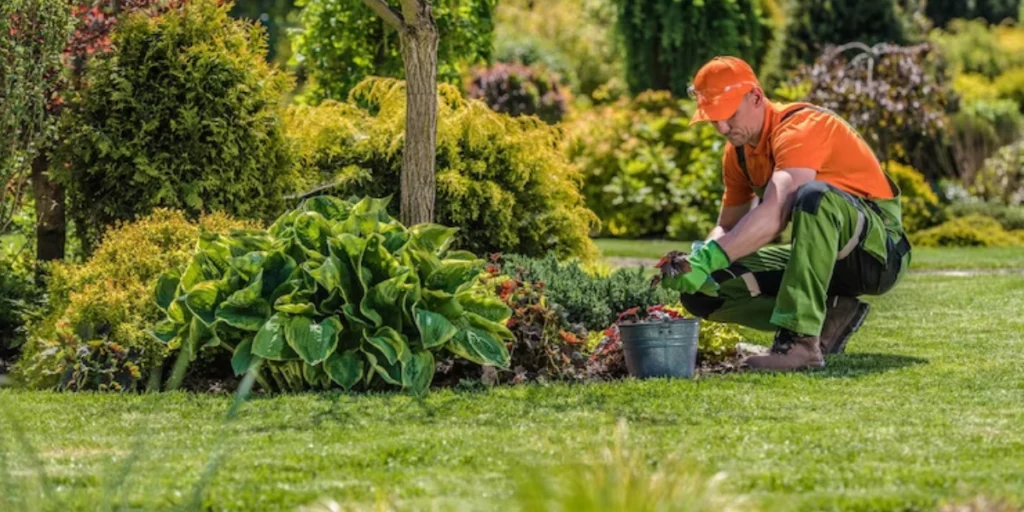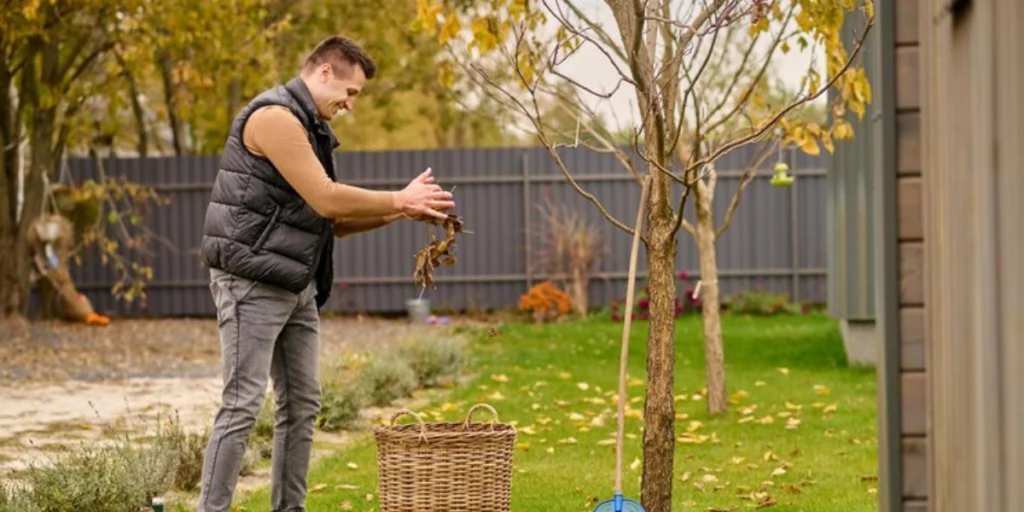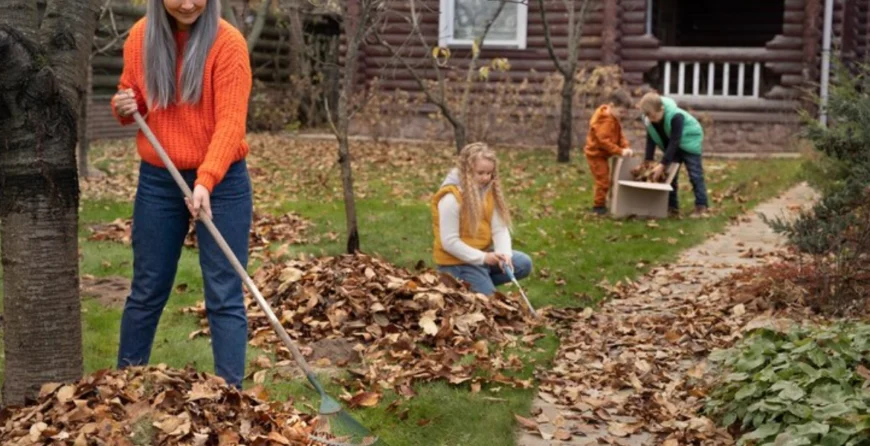Landscaping is the art and science of improving the appearance of an area of land by modifying its contours or design, planting trees, grasses, flowers, or shrubs, erecting architectural features like fences, pavilions, or gazebos, building ponds and paths, and carrying out other improvements. In this article, we will explore what landscaping is, the different types of landscaping work, and how to get started with landscaping your property.
What is Landscaping Work?
Landscaping work involves modifying, designing, constructing, and maintaining outdoor spaces to achieve functional, aesthetic, or environmental goals. Some common forms of landscaping work include:
- Planting trees, flowers, shrubs, grasses, and other vegetation. This helps beautify the space and provide aesthetic appeal.
- Designing and installing hardscapes like patios, walkways, retaining walls, ponds, fountains, and other architectural features. This defines outdoor spaces and adds functional elements.
- Grading and modifying land contours through processes like excavating or adding fill dirt. This is done to shape the land, direct water flow, or achieve a particular landscape design vision.
- Constructing drainage systems to manage stormwater runoff and prevent erosion or flooding. This maintains the long-term integrity of the landscape.
- Installing automatic sprinkler systems to water plants and support healthy vegetation. This helps landscapes thrive with minimal labor input.
- Providing landscape maintenance like mowing, pruning, weeding, fertilizing, and pest control. Proper maintenance keeps the landscape looking its best over the long term.
So in summary, landscaping work transforms the existing conditions of a site through deliberate modifications, improvements, and ongoing care. The goal is an aesthetically pleasing, functional outdoor environment.
What is Landscaping Design?

Landscaping design is the process of planning and designing improvements to outdoor spaces through hardscaping, vegetation selection, and placement. Good landscape design achieves multiple objectives:
- Aesthetic Objectives: Creating a visually appealing outdoor space through the harmonious arrangement of plants, architectural features, and other elements.
- Ecological Objectives: Selecting native/appropriate plants and designing functional drainage to support a sustainable landscape.
- Functional Objectives: Designing usable outdoor areas for recreation, entertainment, stormwater management, and more.
- Accessibility Objectives: Ensuring the landscape can be safely accessed and enjoyed by people of all ages and abilities.
Elements of landscape design include developing a base plan, selecting materials, choosing plants, determining lighting and irrigation needs, and more. Professional landscape designers blend art and science to transform outdoor areas into beautiful, purpose-built spaces.
What is Landscaping in Construction?
Landscaping plays an important role in residential and commercial construction projects. During construction, landscaping aims to:
- Protect Existing Vegetation: Marking and preserving mature trees, shrubs, and plants where possible during the construction process.
- Erosion Control: Installing landscaping like grass, native groundcovers, or mulch to prevent topsoil loss from wind and rain erosion.
- Temporary Beautification: Seeding or planting fast-growing annuals to provide temporary aesthetic benefits and prevent weeds.
- Grade Changes: Modifying contours and drainage with berms, swales, or retaining walls to direct water flow appropriately.
- Perimeter Planting: Installing shrubs or trees around construction sites for privacy, windbreaks, and noise buffers.
Once construction is complete, landscaping helps transition projects to their final design through elements like:
- Foundation Planting: Accenting new buildings with shrubs, small trees and groundcovers near foundations.
- Hardscape Installation: Constructing patios, walkways, walls and other permanent landscape features.
- Seeded or Sodded Lawns: Establishing turf for recreation areas, visual appeal and erosion control.
- Specimen Tree and Shrub Placement: Providing long-term architectural framing and design through large plantings.
So in summary, construction landscaping both aids projects during development and brings them to their finished landscape state through site stabilization and beautification.
Types of Landscaping Work
There are different types of landscaping work professionals based on their specific skill sets, services offered, and targeted market segments:
Landscape Designers
Landscape designers create comprehensive landscape plans combining elements like planting, irrigation, drainag, and hardscaping. They work directly with clients on design conceptualization and specifications.
Landscape Contractors
The contractors install and construct the tangible elements of landscape designs, including patios, walls, planting beds, and irrigation systems.
Landscape Maintenance Services
Crews provide ongoing landscape care services like mowing, edging, pruning, fertilization and pest/weed control to keep landscapes healthy and attractive.
Landscape Lighting Specialists
These professionals design, install and program integrated low-voltage lighting systems to accent and enhance nighttime landscapes.
Nurseries & Garden Centers
In addition to retail plant sales, many operate landscape divisions offering design, installation and maintenance packages.
Landscape Architects
Professionally licensed landscape architects handle complex, large-scale commercial and public landscape projects requiring specialized skills.
So in summary, various specialized landscape professionals work together to transform outdoor spaces from initial design through long-term upkeep and care. Determining the right service for each project phase ensures landscape success.
What is Landscaping in Agriculture?

While most often associated with residential and commercial settings, landscaping also plays an important role in agriculture and farming:
- Farmyards & Buildings: Farmhouses, barns and other structures are landscaped for aesthetic appeal as well as wind protection.
- Farm Roads & Paths: Gravel lanes, dirt roads and trails require landscape design for stability, drainage and easy access.
- Shelterbelts: Rows of trees and shrubs provide shelter for livestock and crops from harsh winds and snow.
- Orchards & Vineyards: Fruit tree plantings and grapevines require specialized landscape design, installation and long-term care.
- Pastures & Grazing Areas: Fencing, water access, shade and forage plantings create optimal livestock landscapes.
- Conservation Landscaping: Maintaining native plant strips helps prevent erosion, improve water quality and restore wildlife habitats on agricultural lands.
How to Landscape
Now that we’ve covered what landscaping entails, here are the basic steps homeowners can take to landscape their property:
- Evaluate the Site – Note existing vegetation, hardscapes, soil types, drainage, sun/shade patterns, and other conditions. Consider how the space is currently used.
- Develop a Landscape Plan – Sketch your vision including plant/hardscape placement, lighting, and irrigation needs. Factor in design principles like balance, repetition, and focal points.
- Acquire Materials – Purchase plants, mulch, materials for paths, walls, etc. Coordinate delivery for large installations.
- Prepare the Soil – Remove weeds, and mix in compost to improve structure/nutrition as needed.
- Install Hardscapes – Construct patios, walls, and other permanent structures before planting. Slope surfaces to direct water flow.
- Plant Vegetation – Dig holes, amend the soil as needed, and follow spacing guidelines when situating plants and trees. Stake as required.
- Add Mulch – Spread 2-4 inches of mulch over soil to conserve water, suppress weeds, and moderate temperatures.
- Water & Maintain – Ensure new plantings receive 1 inch of water per week. Mow, prune, fertilize, and control pests over time.
- Enjoy Your Landscape! – Sit back and appreciate the beautiful outdoor space you’ve created. Consider any areas you may wish to expand or modify.
With some planning and elbow grease, even novice gardeners can beautify their outdoor environments through landscaping. The sense of ownership and pride is very rewarding.
Landscaping Features
In addition to plants and hardscapes, other common landscape features further enhance outdoor living areas:
Water Features
Decorative ponds, fountains and streams add visual interest and ambient sounds. Koi ponds blend function and beauty.
Outdoor Lighting
Strategic low-voltage lighting washes ornamental trees, pathways and structures with a soft glow at dusk.
Outdoor Furniture
Chairs, tables, loungers and benches provide comfortable places to relax and entertain amid welcoming plantings.
Fire Features
Outdoor fireplaces, fire pits and chimineas cozily extend use of outdoor spaces into cooler evenings and provide focal points.
Raised Beds & Planters
These defined edges allow growing vegetables, herbs and flowers in compact patches with improved drainage and soil quality.
Garden Structures
Gazebos, pavilions and outdoor rooms complement landscaping while offering shaded gathering spots amongst greenery.
Driveways & Walkways
Creative paving materials like concrete, brick, stone or gravel connect destinations, define circulation routes and compliment surrounding vegetation.
Lawn Games
Bocce ball, cornhole, croquet and badminton encourage outdoor fun and interactivity on expansive turf areas.
Yard Art & Decor
Strategically placed statuary, fountains and functional pieces add visual interest, structure and personality.
Benefits of Landscaping
In addition to visual appeal, well-designed landscapes provide valuable environmental, psychological and financial benefits:
- Increased Property Values – Attractive, well-maintained yards enhance real estate assets according to realtor reports.
- Stormwater Management – Landscaping soaks up and redistributes rainfall, lessening runoff that strains municipal drainage infrastructure.
- Cleaner Air – Photosynthesizing plants naturally produce oxygen and filter airborne particulates in their vicinity.
- Wildlife Habitats – Native perennials, shrubs and trees provide food and shelter supporting declining bird and insect populations.
- Privacy & Noise Screening – Dense vegetation forms visual and sound barriers separating spaces or filter nearby distractions.
- Mental Wellness – Exposure to nature boosts mood, reduces stress and induces calming physiological effects.
- Outdoor Living Spaces – Landscapes transform formerly unused areas into inviting living, dining and activity hubs.
Conclusion
In closing, we hope this in-depth exploration of what landscaping is provided valuable insights into the various fields, processes and techniques involved. Whether you are a homeowner looking to improve your property, commercial client upgrading your business landscape, or professional entering the industry, a solid understanding of landscaping fundamentals is key to success.
For exceptional landscape design, installation and maintenance services in the Lowell MA area, contact us at sfmarbleangranite@gmail.com or 978-459-5829. I Haul Landscaping Services has over 20 years of experience transforming both residential and commercial outdoor spaces. Visit us at our showroom located at 755 Dutton St, Lowell, MA 01854 to discuss your project and receive a free consultation and estimate. Our skilled landscape professionals are ready to help you achieve the beautiful outdoor landscape you envision.
FAQs
How much does it cost to landscape a yard?
The cost of landscaping can vary significantly depending on the size of the yard, materials used, hardscape elements included, and other design factors.
Is it better to use annuals or perennials in landscaping?
Both annuals and perennials have advantages for landscaping. Annuals provide bright seasonal color but require replanting each year.
How often do I need to water new landscaping?
Newly planted vegetation requires regular watering to become established. Water deeply once per week if it does not rain, allowing the top few inches of soil to dry slightly between waterings.
What is the best way to edge a landscape bed?
Common edging materials include plastic, aluminum, brick, concrete or stone. For a natural look, use landscaping timbers or fieldstone.
Will rats and mice be attracted to landscaping?
It’s unlikely landscaping alone will cause rodent issues as long as plants and mulch are not in direct contact with the home.

